|
|
The monthly British car production average during 1952 was 37,334 of which 22,979 (complete) and 2,840 (chassis only) were exported. Although there was still a shortage of new cars for the domestic market things were looking decidedly brighter. The general state of British roads and the Government's attitude towards the problem came in for a great deal of criticism from many quarters. The chairman of The Berkshire Highways Committee said in his report on the condition of that county's roads ... 'There is a very small margin between the present condition of the roads and a condition which would be wholly unsatissfactory'. On the design front overhead-valve engines were rapidly replacing the side-valve variety and engine sizes were gradually increased.
More attention was being given to producing wings and grilles which could be removed easily for repair and-following the demands of overseas buyers -to rust-proofing and dust-sealing. Petrol tanks and spare wheels were to be found in some unexpected places, in the search for more luggage space. Although many of the models were changed only in detail from the previous year, the public did see the arrival of the new Austin A30 Seven and the restyled Vauxhall Wyvern and Velox. Of the year's total car production of 448,000 no fewer than 308,942 were exported, valued at nearly £111 million. Imports were down to just under 1900 cars and the total of new car registrations in the UK was 196,469 (including 5432 hackneys). |
 |
 |
 |
AC 2-Litre Saloon |
| |
Also see: AC Road Tests and Reviews | AC Cars Brochures |
| |
The AC 2-Litre two-door Saloon was continued from the previous years and in October was joined by a four-door model. The Drophead Coupe had been discontinued but the Buckland Tourer (see 1950) was still available. |
|
 |
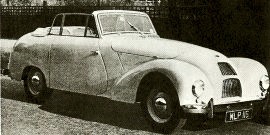 |
 |
Allard M2X Drophead Coupe |
| |
|
| |
The Allard M2X Drophead Coupe was introduced in November 1951. and based on the P1 Saloon (introduced 1949) but with an 'A' -shaped radiator grille and floor-mounted gear-change. This model-powered by a Ford V8 3·6-litre engine was very much in the Allard tradition. An Armstrong Siddeley Whitley modified version of the J2 called the J2X was also announced for 1952. The 'X' indicated that in the front suspension arrangement the radius arms were ahead of the front axle. |
|
 |
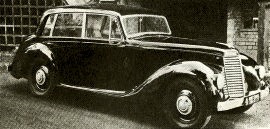 |
 |
Armstrong Siddeley Whitley Six-Light Saloon |
| |
|
| |
The Armstrong Siddeley Whitley six-light Saloon joined the four-light version (see 1950) in March 1952. This later version had rear quarter lights added to give extra visibility and the rear of the car was rearranged to provide better leg room. The Lancaster Saloon was discontinued in March 1952. |
|
 |
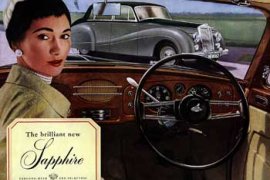 |
 |
Armstrong Siddeley Sapphire |
| |
|
| |
|
|
 |
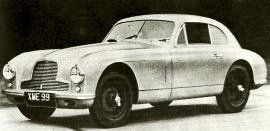 |
 |
Aston Martin DB2 Saloon |
| |
Also see: Aston Martin Road Tests and Reviews |
| |
The Aston Martin DB2 Saloon. Models from October 1951 were distinguishable by the one-piece radiator and brake duct grille. In 1952 a, privately-owned DB2 came third in the Le Mans 3-litre class and seventh overall. |
|
 |
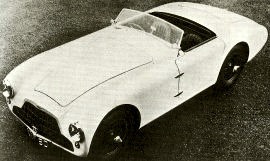 |
 |
Aston Martin DB3 Sports Roadster |
| |
Also see: Aston Martin Road Tests and Reviews |
| |
The Aston Martin DB3 Sports Roadster was a limited-production model, sold primarily for competition work and powered by a six-cylinder 2580-cc (2922-cc from late 1952) double-OHV engine driving through a five-speed gearbox coupled to a DeDion type rear axle. A factory-entered DB3 won the Nine-hour Race at Goodwood in 1952 - the model's first major victory. |
|
 |
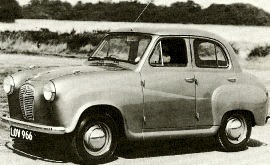 |
 |
Austin A30 Model AS3 Saloon |
| |
Also see: Aston Martin Road Tests and Reviews |
| |
The Austin A30 Model AS3 Saloon started its successful production run in October 1951. Of conventional layout it featured an 803-cc 28-bhp, OHV Four engine, four-speed gearbox, hypoid-bevel final-drive, coil-spring independent front suspension (IFS) and semiielliptic leaf-spring rear suspension, and was the first Austin to use the chassisless integral construction format. Although a four-door car, two-door models were introduced later - rear seat entry was difficult and occupation cramped. It sold at £529 and was initially designated Austin Seven. |
|
 |
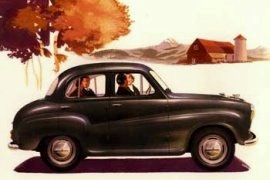 |
|
 |
 |
|
 |
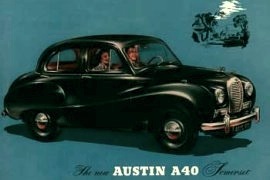 |
 |
Austin A40 Somerset |
| |
Also see: Austin Road Tests and Reviews |
| |
The Austin A40 Somerset Model GS4 Saloon was introduced in February 1952. Virtually a scaled-down version of the A70 Hereford this model was mechanically similar to the preceding A40 Devon (1948-52), but with various detail improvements including a slight increase in bhp (42 v. 40) from the 1200-cc engine. The new body styling was well planned with wider rear doors giving better access to rear seats, more passenger space and better soundproofing. |
|
 |
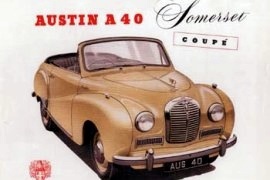 |
 |
Austin A40 Somerset Coupe |
| |
Also see: Austin Road Tests and Reviews |
| |
The Austin A40 Somerset Model GD5 Drophead Coupe joined the saloon in August 1952. It had similar dimensions to the saloon except that the overall height was slightly less. The top could be used in three positions, i.e. fully raised, 'coupe de ville' or stowed behind the rear seat. The rear quarter windows could be swivelled down into the body sides. |
|
 |
 |
|
 |
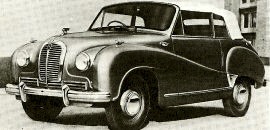 |
 |
Austin A70 Hereford Model 8D3 Drophead Coupe |
| |
Also see: Austin Road Tests and Reviews |
| |
The Austin A70 Hereford Model 8D3 Drophead Coupe looked much like its A40 counterpart but was larger It was discontinued in July. |
|
 |
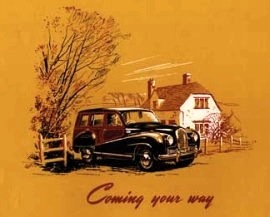 |
|
 |
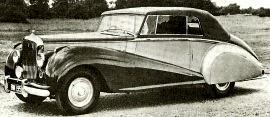 |
 |
Bentley Mark VI Saloon |
| |
Also see: Bentley Austin Road Tests and Reviews |
| |
The Bentley Mark VI Saloon underwent its first significant change since its introduction in 1946. The cylinder bore size was increased to 92 mm in October 1951 so giving the engine a 4566-cc cubic capacity. The model shown is a Drophead Coupe by Park Ward & Co. Ltd. |
|
 |
 |
 |
Daimler Regency Saloon |
| |
Also see: Daimler Austin Road Tests and Reviews |
| |
The Daimler Regency Saloon was announced at the London Motor Show in October 1951. It was a 90-bhp 3-litre-engined, luxury four-door model with modern lines but nevertheless traditionally very much a Daimler. It was built primarily as a result of the strong overseas demand for a large capacity car with good ground clearance, plus six-seater accommodation well hidden by graceful body styling. Surprisingly, only a few of these versions were built. A 3½-litre Regency Mark II did, however, go into production late in 1954. |
|
 |
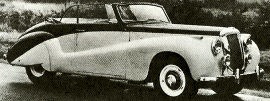 |
 |
Daimler 3-Litre Convertible Coupe |
| |
Also see: Daimler Austin Road Tests and Reviews |
| |
Daimler 3-Litre Convertible Coupe, a Barker-bodied, two-door luxury model built on the 2952-cc Regency chassis in 1952. Engine performance was increased by the use of an aluminium cylinder head and a higher compression ratio which pushed its output up to 100 bhp at 4200 rpm. Features of this model included twin fuel tankssone beneath each rear wing-and power-operated top, windows and luggage boot lid. Only a few were ever built. |
|
 |
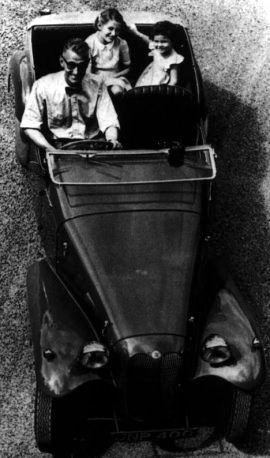 |
 |
Dellow Mark III Sports Tourer |
| |
|
| |
Dellow cars were made in a factory at Alvechurch, near Birmingham, England between 1949 and 1956. Dellow Motors Ltd was started by Ken Delingpole and Ron Lowe to produce road-going sports cars for the enthusiast to use in trials, rallies and hill-climbs. A small number of very early cars used Austin 7 chassis as per Ron Lowe's special, FUY 374.The other protypes included OP 3835 owned by Earl "Mick" Heighway, HAB 245 (Eric Penn) CAB 282 (Lewis Tracey) and EDE 384 (Merrick)From 1950, with scrap Austin 7's in short supply,Dellows used an 1172cc Ford 10 engine in an A-frame chassis with a very light tubular steel framework welded to the chassis and panelled in aluminium, early cars having no doors.
The chassis frames were made partly from government surplus chrome-molybdenum rocket tubes, the rockets being RP3 types as used by Hawker Typhoon and Bristol Beaufighter aircraft. The design emphasis was on light weight and a rearward weight bias for trials. Many sporting awards were won by drivers of Dellow cars in the early 1950s, not only in trials but also in other events such as driving tests and hillclimbs. Dellows also took overall honours in the MCC organised Daily Express National Rally and the Circuit of Ireland Rally. Dellow drivers often shone in other forms of motor sport, Tony Marsh from Kinver went on to become RAC Hill Climb Champion on no less than 6 occasions. Peter Collins from Kidderminster, later drove for HWM, BRM and Vanwall, then for Ferrari.
Dellow styling was created by Lionel Evans at his Radpanels coachbuilding business in Kidderminster. The car evolved through several variants known as Mk I to Mk V. Early cars had the Ford beam front axle with transverse spring and short Panhard rod, quarter elliptics at the rear and Andre Hartford friction dampers all round. The Ford torque-tube was suitably shortened and the vast majority of cars used the 3-speed Ford gearbox but a very small number of cars (KOX 300 being one of them) were produced to customer order with a 4 speed gearbox, from the 10M series Morris.
The Ford E93A engines were mildly tuned and many used twin SU's on a cast alloy 'Dellow' manifold. However, as an option the factory also offered the car with a Wade-Ventor (Roots type) supercharger installation. The MkII saw the introduction of a new and much more robust rear chassis section with coil springs, separate telescopic shock absorbers and a Panhard rod. This stiffer chassis allowed doors to become an optional fitting. The Mk V version was derived from the "Lightweight" Dellow (WRF 81) constructed by Tony Marsh for speed events in 1954. It saw coil springs introduced at the front (over telescopic dampers) although still with a one-piece Ford beam axle. About 300 Dellows in total are believed to have been constructed.
A new company, Dellow Engineering, based in Oldbury near Birmingham produced a Mk VI - often incorrectly quoted as having a glass fibre body, it too was in fact built with alloy panelling. Very few Mk VI's were made. |
|
 |
 |
 |
Dellow Mark III Sports Tourer |
| |
|
| |
The Dellow Mark III Sports Tourer, a four-seater model, was introduced in April 1952. Based on the two-seater but with a 1-foot longer wheelbase; the body was 7 in longer and 2 in wider. Full hood (top) and sidescreens were provided and the sidelamps were moved to the wings. The handiness and feel were somewhat reduced on the four-seater-the turning circle, for example went up by almost 4 feet. Sold at £774. |
|
 |
 |
 |
Ford Consul Model EOTA Saloon |
| |
Also see: Ford UK Road Tests and Reviews |
| |
The Ford Consul Model EOTA Saloon was a carryover from 1951. ln September 1952 the dashboard was revised and the instruments centred round the steering column. Shown in the background is Anne Hathaway's Cottage - the home of Shakespeare's wife in Stratford, Avon. |
|
 |
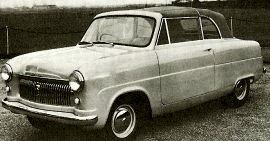 |
 |
Ford Consul and Zephyr Six Drophead Coupes |
| |
Also see: Ford UK Road Tests and Reviews |
| |
The Ford Consul and Zephyr Six Drophead Coupes were mechanically similar to their respective saloon versions. These two-door models had a folding top which could be power-operated to the halfway position: manual operation was required to close it fully or to take it back to this position. Unlike the saloons, they had a divided front seat, each section being separately adjustable with a tilting squab. |
|
 |
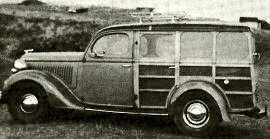 |
 |
Ford Pilot V8 |
| |
Also see: Ford UK Road Tests and Reviews |
| |
The Ford Pilot V8 was officially discontinued the previous year but this is an export model that was supplied in 1952. Fitted with Shooting Brake bodywork it was based on the commercial pickup chassis/cab with 3·89 axle ratio and rod/cable rear brakes. |
|
 |
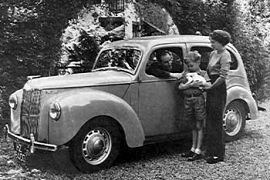 |
|
 |
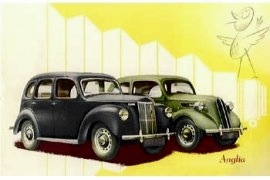 |
|
 |
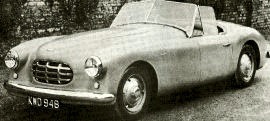 |
 |
Healey 3-Litre Sports Convertible Series G |
| |
Also see: Austin-Healey Road Tests and Reviews |
| |
The Healey 3-Litre Sports Convertible (Series G) with Alvis engine and gearbox had similar body styling to the earlier Nash-Healey Sports Roadster which was made for and sold on the export market during 1950-52 (a modified version followed up until the end of 1954). Popularly known as the Alvis-Healey, it had a two/three-seater Healey-built body with full weather equipment. The 2993-cc power unit developed 106 bhp at 4200 rpm. Only 25 were built. |
|
 |
 |
 |
Healey Abbott Drophead Coupe |
| |
Also see: Austin-Healey Road Tests and Reviews |
| |
The Healey Abbott Drophead Coupe was a two-door soft-top version of the Tickford Saloon. From approximately November 1951 onwards it was built on an F-type chassis. Only 77 were made (1950-54). |
|
 |
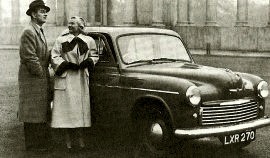 |
 |
Hillman Minx Mark V Saloon |
| |
Also see: Hillman Road Tests and Reviews |
| |
The Hillman Minx Mark V Saloon replaced the Mark IV in October 1951, the only visible differences being chrome side strips along the body, side pieces on the radiator grille, plated stoneguards on the rear wings and improved bumpers. Various interior and mechanical modifications were also made. Shown are actors Anne Todd and Nigel Patrick beside a Mark V Minx in a scene from the famous David Lean Cineguild film production 'The Sound Barrier'. |
|
 |
 |
 |
Humber Pullman Mark III and Imperial Mark III |
| |
Also see: Humber Road Tests and Reviews |
| |
The Humber Pullman Mark III and Imperial Mark III were similar in most respects Wheelbase was 10ft 11 in, engine a 100-bhp 4-litre OHV Six Both were eight-seaters, bodied by Thrupp & Maberly. Other contemporary Humbers were the Hawk Mark IV and Super Snipe Mark Ill. |
|
 |
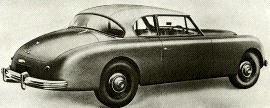 |
 |
Jensen Interceptor Saloon |
| |
Also see: Jensen Road Tests and Reviews |
| |
The Jensen Interceptor Saloon was a hardtop version of the Interceptor Cabriolet, with fabric covered roof and fixed quarter windows, The Saloon had extra leg room because the rear seat was located farther back than on the Cabriolet which had to accommodate the hood (top) recess. |
|
 |
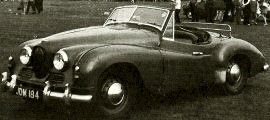 |
 |
Jowett Jupiter |
| |
|
| |
The Jowett company-founded by Benjamin and William Jowett and A. V. Lamb on £30-had completed fifty years. The successful Jupiter was continued with detail modifications including a redesigned fascia/instrument panel. Pictured left is a production-bodied Jupiter. There was a special-bodied Jowett Jupiter version by J. J. Armstrong of Carlisle. Other specialist coachbuilders also adapted the Jupiter chassis, including Abbott of Farnham, J. E. Farr & Son of Blackburn and Richard Meade of Knowle. Warwicks. |
|
 |
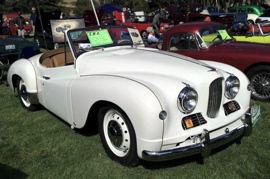 |
 |
Jowett Jupiter |
| |
|
| |
The Jowett Jupiter featured an all aluminum body, as steel was either expensive or tough to come by after World War 2. The body was hand formed, so no two were exactly alike, nor were wings interchangeable - a panel-beaters nightmare. Thisq was a true 2 seater with a lot of storage behind the seats but no trunk lid to access it. The spare tyre was stowed underneath the rear and exposed by undoing 2 latches and dropping a panel. The Jupiter had a questionable drive train configuration with a lot of weight on the front axle from horizontal opposed 4 cylinder engine with radiator behind it. The transmission was 4 speed on the column. For the final year of production Jowett included a rear jump-seat. Jowett went out of business in 1953 being unable to compete with all the innovations of the day. |
|
 |
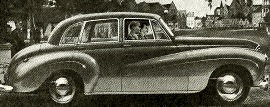 |
 |
Lanchester Leda Series LJ201 Saloon |
| |
|
| |
The Lanchester Leda Series LJ201 Saloon was introduced April 1952. solely for the export market. Externally identical to the Fourteen it differed in having an all-steel instead of the wood and metal construction of the regular Barker-bodied models. It was discontinued in April 1953. |
|
 |
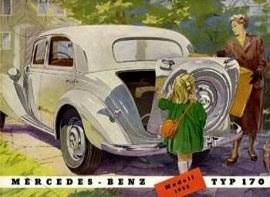 |
|
 |
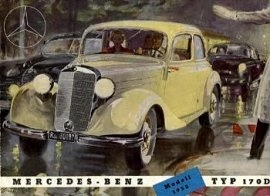 |
|
 |
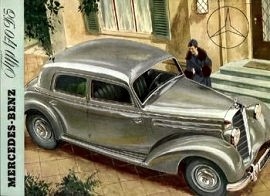 |
|
 |
 |
|
 |
 |
|
 |
 |
|
 |
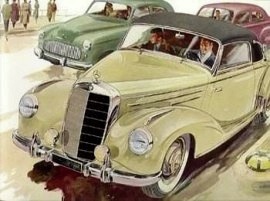 |
|
 |
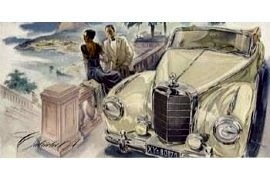 |
|
 |
 |
|
 |
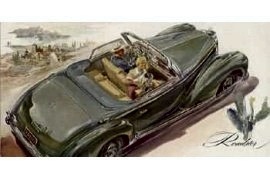 |
|
 |
 |
 |
MG 1¼-Litre Series YB Saloon |
| |
Also see: MG Car Reviews and The MG Story |
| |
The MG 1¼-Litre Series YB Saloon superseded the 1947-51 Series Y model for 1952. The only major change was the fitting of a hypoid rear axle in place of the spiral bevel type. It was powered by a single-carburettor version of the popular MG 1250-cc OHV engine and featured as standard a sliding roof and an opening windscreen. It was discontinued in the summer of 1953. |
|
 |
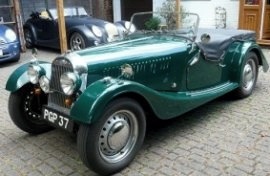 |
 |
Morgan Plus Four Four-Seater Tourer |
| |
Also see: Morgan Road Tests and Reviews |
| |
The Morgan Plus Four, Four-Seater Tourer was an addition to the existing range (Tourer and Coupe). Generally similar to the two-seater sports models it differed mainly by having two extra seats, with the petrol tank carried beneath, a single spare wheel (two on the Sports) and a single 12-volt battery under the bonnet. |
|
 |
 |
 |
Morris Oxford MO Traveller Estate |
| |
Also see: Morris Road Tests and Reviews |
| |
The Morris Oxford MO Traveller Estate Car made its appearance in September 1952 and is shown with the then current radiator grille. From October all Oxford models had a restyled grille with two horizontal bars. The Traveller had the same 1476-cc side-valve engine as the contemporary Oxford Saloon. Other Morris cars at this time were the Minor, which in late 1952 received an OHV engine (Series II), and the 2·2-litre Model MS Six. |
|
 |
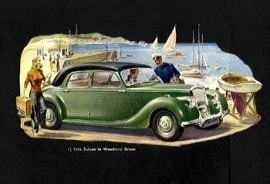 |
|
 |
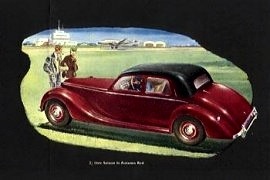 |
|
 |
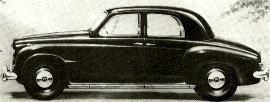 |
 |
Rover 75 Series P4 Saloon |
| |
Also see: Rover Road Tests and Reviews | Rover Brochures |
| |
Modifications for the 1952 season included a neater frontal appearance with a new vertical-slat radiator grille-the central fog lamp was deleted-flanked by headlamps mounted in circular instead of square recesses in the wing valances, with the sidelamps located atop the wings. The size of the rear window was increased. The 2103-cc six-cylinder engine had overhead inlet and inclined side exhaust valves and produced 75 bhp at 4200 rpm. |
|
 |
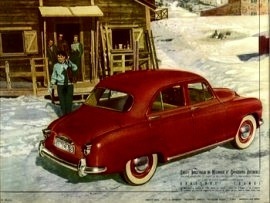 |
|
 |
 |
 |
Singer SM 1500 Saloon |
| |
Also see: Singer Road Tests and Reviews |
| |
The Singer SM 1500 Saloon continued virtually unchanged from previous year, during which the interior had received a face-lift and the engine was given a reduction in stroke (89 v. 90 mm) to bring it under the 1500-cc rating (1497 v. 1506 cc) This engine modification also applied to the export-only Roadster. The SM1500 Saloon was originally introduced in 1948 and continued until 1954. In January 1952 the headlamps were raised. |
|
 |
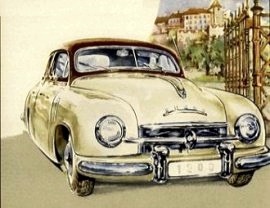 |
|
 |
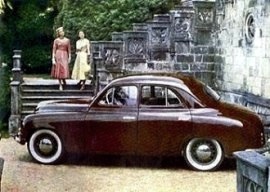 |
|
 |
 |
 |
Standard Vanguard Series 20S Saloon |
| |
Also see: Standard Road Tests and Reviews |
| |
The Standard Vanguard Series 20S Saloon was given something of an external face-lift for 1952 with the adoption of a slightly lower bonnet line, a wide almost rectangular chrome-plated air-intake with a central horizontal bar, a wider rear window and push button door handles. |
|
 |
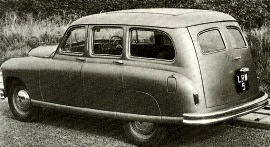 |
 |
Standard Vanguard Estate |
| |
Also see: Standard Road Tests and Reviews |
| |
The Standard Vanguard Estate for 1952 received the same face-lift as the Saloon (see 34D). Known as the Phase I models, this range was superseded by revised Phase II models early in 1953. |
|
 |
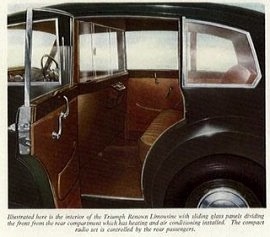 |
|
 |
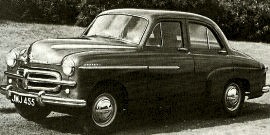 |
 |
Vauxhall Velox Model EIP Saloon |
| |
Also see: Vauxhall Road Tests and Reviews |
| |
The. Vauxhall Velox (Model EIP) and Wyvern (Model EIX) Saloons, announced in August 1951, were the first really new post-war Vauxhall models. They featured full-width body styling, curved windscreen, 8 ft 7 in wheelbase and coil spring and wishbone independent front suspension. All doors were hinged at their front edges and had pushbutton catches. |
|
 |
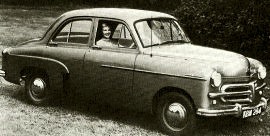 |
 |
Vauxhall Wyvern Model EIX Saloon |
| |
Also see: Vauxhall Road Tests and Reviews |
| |
The four-cylinder 1½-litre-engined Wyvern was distinguished externally from the six-cylinder 2¼-litre-engined Velox by having wheels finished in body colours (cream on Velox) body-coloured flashes on the front wings (chromium on Velox) and different badges As before the body was of unitary construction but separate chassis were produced for export to Australia where locally-made Tourer bodywork was fitted The bonnet could be opened from either side or removed altogether (until June 1953 when an alligator-type bonnet was introduced). |
|
 |
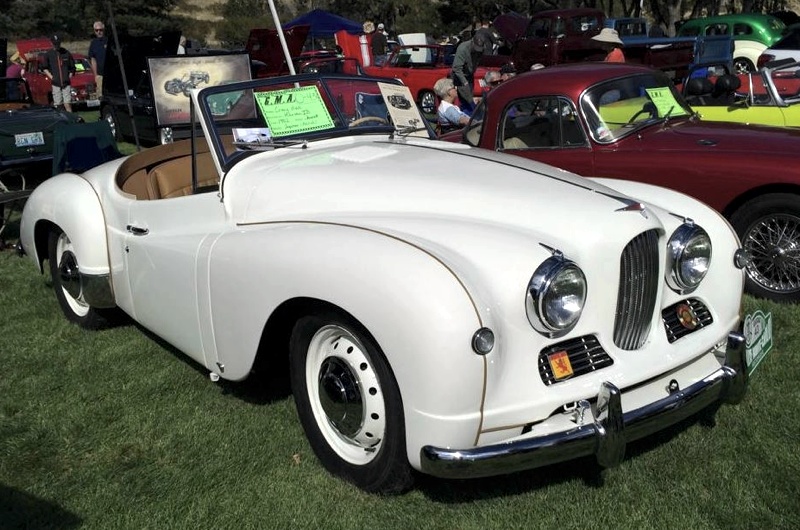 1952 Jowett Jupiter.
1952 Jowett Jupiter. |
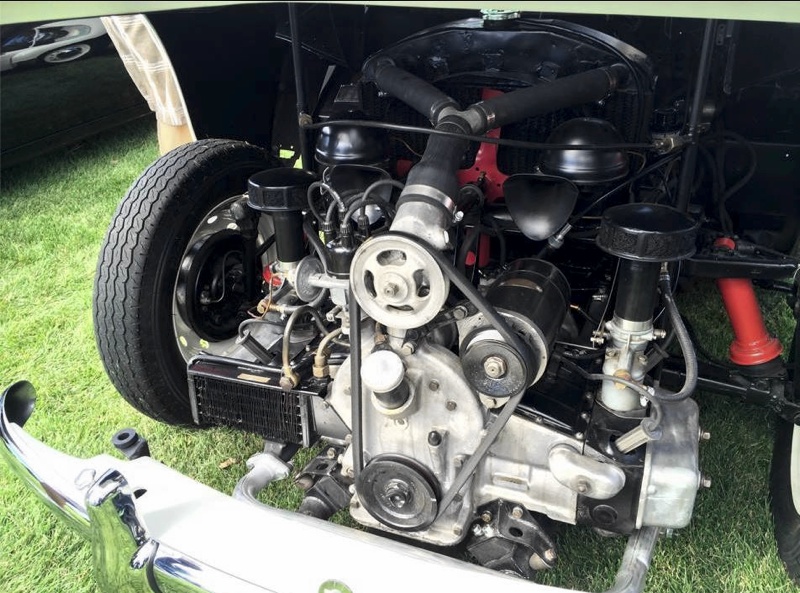 1952 Jowett Jupiter engine bay.
1952 Jowett Jupiter engine bay. |
|
|
Sell Your Car or Parts
Browse the Classifieds
It's Absolutely Free! - Find Out More
|



